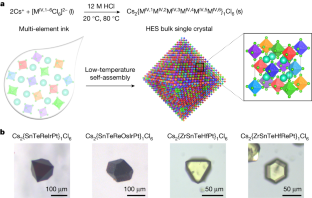2023-09-28 アメリカ合衆国・ローレンスバークレー国立研究所(LBNL)

・ LBNL とカリフォルニア大学バークレー校(UCB)が、高エントロピー半導体(HES)のコスト効果的でエネルギー高効率な製造を可能にする「マルチエレメントインク」を開発。
・ 低温や室温下で製造できる初の HES 材料として、次世代のマイクロエレクトロニクス、固体照明やディスプレイ等のデバイスの持続可能な製造を加速させる。
・ 多くの電子デバイスに不可欠な半導体製造はエネルギー集約的で、砂(酸化ケイ素)からの半導体材料の製造には 2,700℉(約 1,482℃)もの高温度の熱エネルギーを使用し、主要な CO2 排出源の一つとなっている。
・ 高エントロピー材料は、ほぼ同程度の割合で一つの結晶系へと自己組成する 5 種類以上の元素から成る固体。この材料の利用による、最低限のエネルギー量で自己組成する半導体材料の開発が長らく試みられている。
・ 今回は、HES 製の硬質合金と、柔らかくフレキシブルな結晶性の金属ハライドペロブスカイトの 2 種類のユニークな半導体を活用。太陽光発電分野で長らく研究されている金属ハライドペロブスカイトの特性を利用することで、高エントロピー合金材料合成の産業規模への拡大を阻む、1,000℃超(約 1,832℉超)の高温度を要する課題に対処した。
・ 金属ハライドペロブスカイトは、約 300℉(約 149℃)の低温度下で溶液から容易に製造できるため、半導体製造のエネルギーコストを大幅に低減できる材料。本研究では、20℃の室温下と 80℃(約 176℉)の低温度下にて、マルチエレメントインク溶液中での自己組成プロセスを通じ、高エントロピーハライドペロブスカイト単結晶の合成を試みた。
・ LBNL の放射光施設(ALS)にて、合成された八面体と立方八面体の結晶が高エントロピー金属ハライドペロブスカイトの単結晶であることを確認。ジルコニウム(Zr)、スズ(Sn)、テルル(Te)、ハフニウム(Hf)、
白金(Pt)の 5 種類の元素による結晶と、Sn、Te、レニウム(Re)、オスミウム(Os)、イリジウム(Ir)、Pt の 6
種類の元素による結晶を作製。各結晶のサイズは約 30~100 ㎛。低温度/室温下、1 時間以内での溶液の混合と析出により、従来の半導体製造技術に比べ飛躍的に迅速に 単結晶半導体を合成した。
・ 今後は固体照明やディスプレイに向けた、持続可能な半導体材料の開発を進める。本研究は、米国エネルギー省(DOE) 科学局(SC)が支援した。
URL: https://newscenter.lbl.gov/2023/09/28/accelerating-sustainable-semiconductors-with-multielement-ink/
<NEDO海外技術情報より>
関連情報
Nature 掲載論文(フルテキスト)
High-entropy halide perovskite single crystals stabilized by mild chemistry
URL:https://www.nature.com/articles/s41586-023-06396-
8.epdf?sharing_token=68y2OCCvNin3AFTOw7FPJNRgN0jAjWel9jnR3ZoTv0N3vKcBgroe5Xgsv1
X40CoAUeJn3wPOllHzmuC_woMDqM3MJf4udMKksQfQJXNviL2FCfsbPb5X3AKfGFecsbk9urKL
UPQpz2cyeAPH8dbaWXNtu_LR8unMQvK34yUzf1A%3D
Abstract
Although high-entropy materials are excellent candidates for a range of functional materials, their formation traditionally requires high-temperature synthetic procedures of over 1,000 °C and complex processing techniques such as hot rolling1,2,3,4,5. One route to address the extreme synthetic requirements for high-entropy materials should involve the design of crystal structures with ionic bonding networks and low cohesive energies. Here we develop room-temperature-solution (20 °C) and low-temperature-solution (80 °C) synthesis procedures for a new class of metal halide perovskite high-entropy semiconductor (HES) single crystals. Due to the soft, ionic lattice nature of metal halide perovskites, these HES single crystals are designed on the cubic Cs2MCl6 (M=Zr4+, Sn4+, Te4+, Hf4+, Re4+, Os4+, Ir4+ or Pt4+) vacancy-ordered double-perovskite structure from the self-assembly of stabilized complexes in multi-element inks, namely free Cs+ cations and five or six different isolated [MCl6]2– anionic octahedral molecules well-mixed in strong hydrochloric acid. The resulting single-phase single crystals span two HES families of five and six elements occupying the M-site as a random alloy in near-equimolar ratios, with the overall Cs2MCl6 crystal structure and stoichiometry maintained. The incorporation of various [MCl6]2– octahedral molecular orbitals disordered across high-entropy five- and six-element Cs2MCl6 single crystals produces complex vibrational and electronic structures with energy transfer interactions between the confined exciton states of the five or six different isolated octahedral molecules.


 エス・ジー・シー佐賀航空セスナ172P型の重大インシデント[他の航空機等が使用中の滑走路への着陸の試み](佐賀空港、令和4年12月12日発生)](https://tiisys.com/wp-content/uploads/2023/11/esugishi-500x346.png)
